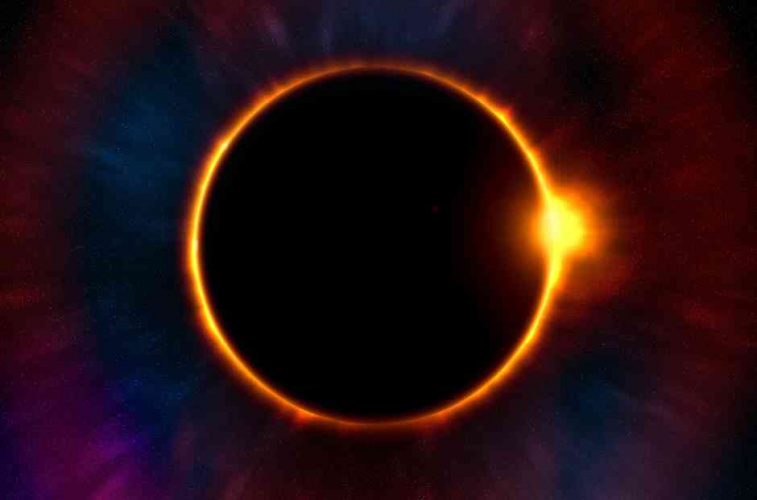Sci-fi eye
 The Moon is often portrayed as a dead world, but it is rich with fictional potential, as Gareth L Powell explains
The Moon is often portrayed as a dead world, but it is rich with fictional potential, as Gareth L Powell explains
Fifty years on from Apollo, most of the discussions around returning to the Moon focus on mining or colonisation. Both could be useful and even profitable enterprises, but are there other, more off-the-wall reasons to visit our celestial companion? Could the Moon help us fight climate change?
Lots of people have suggested covering the Moon’s surface with solar cells in order to harvest a lot of clean energy and beam it back to receiving stations on Earth. But why stop there? As a science-fiction author, my job is to take inspiration from today’s headlines and add a dash of wild speculation.

So, how about we make the Moon’s shadow larger?
Imagine building a 1,000km-high mast on the Moon, at the border between its visible and hidden faces. Now imagine building another 100km away, and then another. Eventually, you get the visible Moon ringed by these huge spikes, like a grapefruit with hundreds of cocktail sticks stuck in it. Now imagine we hang mirrored material between these masts. This would make the Moon appear much larger and therefore blot out the Sun’s rays over a wider area of the Earth’s surface, reducing the amount of sunlight reaching the Earth by a small but significant fraction.
___________________________________________________
Further reading
- Apollo 11: half a century on
- Return to the Moon may help earthlings
- Are geoengineering opponents short sighted?
_____________________________________________________________________________
Not wild enough? Okay then, how about we draw down the Moon?
Since its formation, the Moon has been gradually pulling away from the Earth at a speed of almost 4cm per year. Although that doesn’t sound like much, it is enough to subtly slow the Earth’s rotation, increasing the length of our days.
One-and-a-half billion years ago, the days on Earth lasted only 18 hours. Now, they last 24 and, in the far future, they may last even longer.
However, if we could use giant motors or near misses by large asteroids to move the Moon closer to the Earth, we could maybe reset this process, using a faster-orbiting Moon to increase the Earth’s rotation and shorten our days.
Why would we want to do that? Well, assuming we could withstand the resultant earthquakes and manage not to drop the entire Moon into the Pacific, the main effect of a shorter day would be that it would give the East and West hemispheres of the Earth less time to warm up in the glare of the Sun. The oceans would have less time to absorb heat, and winters would become colder. In addition, a faster-rotating Earth would give us faster-moving tides, which could have implications for tidal power generation – not to mention surfers.
But if we had such god-like powers of celestial engineering, why stop with simply moving the Moon? Why not find more Moons?
Manoeuvring asteroids and comets into orbits around the Earth would put their resources at our fingertips. I don’t want to start sounding like an eccentric billionaire trying to push a tech start-up, but asteroid mining would provide a cornucopia of ores and minerals, making the idea financially attractive. And if you’re mining material in orbit, it makes sense to process it on-site. You could also move heavy, polluting industries into orbit, decreasing the CO2 emitted into the Earth’s atmosphere.
All those little Moons would also provide more opportunities to create Sun-blocking mirrors to shield our atmosphere from heat. Imagine looking up at the night sky and seeing a ribbon of lights stretching across from one horizon to another, each one a small town or industrial installation.
As a pragmatist, this might sound like a lot of starry-eyed foolishness; but as a writer, the idea’s almost irresistible. It would make a great setting for a story. What would the people who lived on these tiny Moons be like? What kind of societies would they have? Would they be pioneers building a life in the sky, or contracted employees doing months-long shifts in orbit? Would they owe allegiance to one nation, to the whole Earth, or to themselves?
What sort of engineers would be needed in such a world? You’d need to be able to work and thrive in freefall. Perhaps you’d have physical adaptations to help you deal with the long-term health effects of living with reduced gravity. You’d certainly need to adapt your skills and techniques to working in a whole new environment; maybe you’d even need to develop some new ones.
Too often, the Moon is portrayed as a dead world. But with the right kind of imagination, we can see it’s alive with possibilities. The schemes I’ve outlined above are crazy, but as we face the reality of global climate change, the idea of finding a way to naturally cool the planet is an attractive one and moving the Moon would make a heck of a science fiction novel.
Gareth L Powell is a science-fiction novelist born in Bristol and educated in Wales. His novels include the Ack-Ack Macaque trilogy, and the Embers of War space opera trilogy.




Nanogenerator consumes CO2 to generate electricity
Nice to see my my views being backed up by no less a figure than Sabine Hossenfelder https://youtu.be/QoJzs4fA4fo